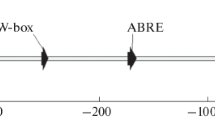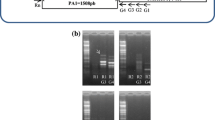Abstract
The features of the expression of the uidA reporter gene, encoding the β-glucuronidase enzyme, under the control of AP3 and RPT2a tissue-specific gene promoters of Arabidopsis thaliana L. was studied in homozygous monoinserted transgenic plants of Nicotiana tabacum L. Both promoters ensured the expression of the reporter gene in the meristematic tissues of tobacco plants, although the type of expression shown for the AP3 promoter was ectopic. In analyzed groups of transgenic plants and their hybrids wide variability in mRNA accumulation and in β-glucuronidase activity was observed. It was shown that the level of accumulation of the uidA reporter gene transcript does not correlate with the level of enzymatic activity of its product. The variability among the analyzed transgenic tobacco plants is most likely associated with the peculiarities of chromatin organization in the regions of T-DNA insertions and/or is caused by the different nature of interactions between the cis-elements of the studied promoters and plant regulatory elements located outside the region of the T-DNA insertion. According to the results of bioinformatic analysis, approximately 20 cis-regulatory elements were identified in the structure of the investigated promoters, some of which were found in both promoters. In general, the results of the analysis showed that the AP3 and RPT2a gene promoters of A. thaliana can be effective as regulatory elements for the expression of transgenes in the meristematic tissues of other plant species, in particular, N. tabacum.




Similar content being viewed by others
REFERENCES
Potenza, C., Aleman, L., and Sengupta-Gopalan, Ch., Targeting transgene expression in research, agricultural, and environmental applications: promoters used in plant transformation, In Vitro Cell. Dev. Biol.: Plant, 2004, vol. 40, p. 1.
Porto, M.S., Pinheiro, M.P.N., Batista, V.G.L., dos Santos, R.C., de Albuquerque Melo Filho, P., and de Lima, L.M., Plant promoters: an approach of structure and function, Mol. Biotechnol., 2014, vol. 56, p. 38. https://doi.org/10.1007/s12033-013-9713-1
Ali, S. and Kim, W.-Ch., A fruitful decade using synthetic promoters in the improvement of transgenic plants, Front. Plant Sci., 2019. V.10, p. 1433. https://doi.org/10.3389/fpls.2019.01433
Smirnova, O.G., Shumny, V.K., and Kochetov, A.V., Regulatory sequences for constitutive, tissue-specific, and induced expression of transgenes in ornamental plants, Russ. J. Plant Physiol., 2019, vol. 66, p. 679. https://doi.org/10.1134/S001533031905018X
Vyacheslavova, A.O., Berdichevets, I.N., Tyurin, A.A., Shimshilashvili, Kh.R., Mustafaev, O.N., and Goldenkova-Pavlova, I.V., Expression of heterologous genes in plant systems: new possibilities, Russ. J. Genet., 2012, vol. 48, p. 1067.
Sonoda, Y., Sako, K., Maki, Y., Yamazaki, N., Yamamoto, H., Ikeda, A., and Yamaguchi, J., Regulation of leaf organ size by the Arabidopsis RPT2a 19S proteasome subunit, Plant J., 2009, vol. 60, p. 68. https://doi.org/10.1111/j.1365-313X.2009.03932.x
Zhang, J., Yan, G., Wen, Z., An, Y.-Q., Singer, S.D., and Liu, Z., Two tobacco AP like gene promoters drive highly specific, tightly regulated and unique expression patterns during floral transition, initiation and development, Planta, 2014, vol. 239, p. 469. https://doi.org/10.1007/s00425-013-1995-9
Komakhin, R.A., Vysotskii, D.A., Shukurov, R.R., Voblikova, V.D., Komakhina, V.V., Strelnikova, S.R., Vetchinkina, E.M., and Babakov, A.V., Novel strong promoter of antimicrobial peptides gene pro-SmAMP2 from chickweed (Stellaria media), BMC Biotechnol., 2016, vol. 16: 43. https://doi.org/10.1186/s12896-016-0273-x
Krizek, B.A. and Meyerowitz, E.M., The Arabidopsis homeotic genes APETALA3 and PISTILLATA are sufficient to provide the B class organ identity function, Development, 1996, vol. 122, p. 11.
Hill, Th.A., Day, C.D., Zondlo, S.C., Thackeray, A.G., and Irish, V.F., Discrete spatial and temporal cis-acting elements regulate transcription of the Arabidopsis floral homeotic gene APETALA3, Development, 1998, vol. 125, p. 1711.
Ueda, M., Matsui, K., Ishiguro, S., Sano, R., Wada, T., Paponov, I., Palme, K., and Okadae, K., The HALTED ROOT gene encoding the 26S proteasome subunit RPT2a is essential for the maintenance of Arabidopsis meristems, Development, 2004, vol. 131, p. 2101. https://doi.org/10.1242/dev.01096
Sidorchuk, Yu.V., Gerasimenko, I.M., Shelud’ko, Yu.V., and Deineko, E.V., Regulatory elements for the expression of transgenes in plant meristems, Vestn. Novosib. Gos. Agrar. Univ., 2017, vol. 4, p. 66.
Koltunow, A.M., Truettner, J., Cox, K.H., Wallroth, M., and Goldberg, R.B., Different temporal and spatial gene expression patterns occur during anther development, Plant Cell, 1990, vol. 2, p. 1201.
Zvereva, S.D. and Romanov, G.A., Reporter genes for plant genetic engineering: characteristics and detection, Russ. J. Plant Physiol., 2000, vol. 47, p. 424.
Bradford, M.M., A rapid and sensitive method for the quantification of microgram quantities of protein utilizing the principle of protein-dye binding, Anal Biochem., 1976, vol. 72, p. 248.
O’Maoileidigh, D.S., Graciet, E., and Wellmer, F., Gene networks controlling Arabidopsis thaliana flower development, New Phytol., 2014, vol. 201, p. 16. https://doi.org/10.1111/nph.12444
Tilly, J.J., Allen, D.W., and Jack, T., The CArG boxes in the promoter of the Arabidopsis floral organ identity gene APETALA3 mediate diverse regulatory effects, Development, 1998, vol. 125, p. 1647.
Gallie, D.R., Sleat, D.E., Watts, J.W., Turner, Ph.C., and Wilson, T.M.A., The 5'-leader sequence of tobacco mosaic virus RNA enhances the expression of foreign gene transcripts in vitro and in vivo, Nucleic Acids Res., 1987, vol. 15, p. 3257.
Kochetov, A.V., Filipenko, E.A., Smirnova, O.G., and Shumnyi, V.K., Translation enhancers for plant gene engineering, Vavilovsk. Zh. Genet. Sel., 2014, vol. 18, p. 610.
Goodrich, J., Puangsomlee, P., Martin, M., Long, D., Meyerowitz, E.M., and Coupland, G.A., Polycomb-group gene regulates homeotic gene expression in Arabidopsis, Nature, 1997, vol. 386, p. 44.
Arce, A.L., Cabello, J.V., and Chan, R.L., Patents on plant transcription factors, Recent Pat. Biotechnol., 2008, vol. 2, p. 209. https://doi.org/10.2174/187220808786241024
Butaye, K.M.J., Cammue, B.P.A., Delaure, S.L., and De Bolle, M.F.C., Approaches to minimize variation of transgene expression in plants, Mol. Breed., 2005, vol. 16, p. 79. https://doi.org/10.1007/s11032-005-4929-9
Bako, A., Gell, G., Zámbo, A., Spitko, T., Pok, I., Pinter, J., and Balazs, E., Monitoring transgene expression levels in different genotypes of field grown maize (Zea mays L.), S. Afr. J. Bot., 2013, vol. 84, p. 6. https://doi.org/10.1016/j.sajb.2012.09.005
Marenkova, T.V., Sidorchuk, Yu.V., Nosov, A.V., Fomenkov, A.A., Kuznetsov, V.V., Mursalimov, S.R., Zagorskaya, A.A., Uvarova, E.A., Belavin, P.A., and Deineko, E.V., Variation in GFP gene expression in Arabidopsis thaliana monoclonal cell lines, Biotekhnologiya, 2019, vol. 35, p. 58.
Marenkova, T.V. and Deineko, E.V., A change in the stability of marker nptII and uidA gene expression in transgenic tobacco plants, Russ. J. Genet., 2006, vol. 42, p. 518.
Goldenkova-Pavlova, I.V., Pavlenko, O.S., Mustafaev, O.N., Deyneko, I.V., Kabardaeva, K.V., and Tyurin, A.A., Computational and experimental tools to monitor the changes in translation efficiency of plant mRNA on a genome-wide scale: advantages, limitations, and solutions, Int. J. Mol. Sci., 2019, vol. 20, p. 33. https://doi.org/10.3390/ijms20010033
Venter, M., Synthetic promoters: genetic control through cis engineering, Trends Plant Sci., 2007, vol. 12, p. 118. https://doi.org/10.1016/j.tplants.2007.01.002
Hernandez-Garcia, C.M. and Finer, J.J., Identification and validation of promoters and cis-acting regulatory elements, Plant Sci., 2014, vols. 217–218, p. 109. https://doi.org/10.1016/j.plantsci.2013.12.007
Jack, T., Brockman, L.L., and Meyerowitz, E.M., The homeotic gene apetala3 of Arabidopsis thaliana encodes a mads box and is expressed in petals and stamens, Cell, 1992, vol. 68, p. 683.
Sawant, S., Singh, P., Gupta, S., Madnala, R., and Tuli, R., Conserved nucleotide sequences in highly expressed genes in plants, J. Genet., 1999, vol. 78, p. 123.
Funding
The study was supported by the budget project no. 0259-2021-0010 “Studying the Metabolic Control Systems of Living Systems in Conditions of Interaction with the Environment after Genetic Modification.”
Author information
Authors and Affiliations
Corresponding author
Ethics declarations
Conflict of interests. The authors declare that they have no conflicts of interest.
Statement on the welfare of humans or animals. This article does not contain any studies involving humans or animals performed by any of the authors.
Additional information
Translated by M. Shulskaya
Rights and permissions
About this article
Cite this article
Sidorchuk, Y.V., Marenkova, T.V., Kuznetsov, V.V. et al. Peculiarities of uidA Gene Expression under the Control of AP3 and RPT2a Tissue-Specific Gene Promotors of Arabidopsis thaliana L. in Nicotiana tabacum L. Transgenic Plants. Russ J Plant Physiol 68, 838–848 (2021). https://doi.org/10.1134/S1021443721040178
Received:
Revised:
Accepted:
Published:
Issue Date:
DOI: https://doi.org/10.1134/S1021443721040178




